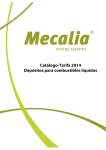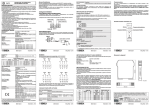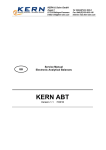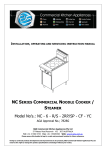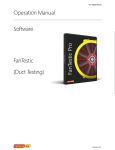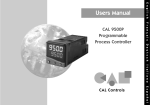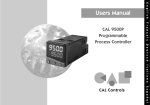Download PAN200 Series Positive and Negative Duct Accreditation
Transcript
ENERGY AND ENERGY COMFORT AND COMFORT Ventilation Testing Positive and Negative Duct Accreditation (PANDA) System Model PAN200 Series Operation and Service Manual Copyright TSI Incorporated / 2012 / All rights reserved. Address TSI Incorporated / 500 Cardigan Road / Shoreview, MN 55126 / USA Fax No. (651) 490-3824 LIMITATION OF WARRANTY AND LIABILITY (effective June 2011) (For country-specific terms and conditions outside of the USA, please visit www.tsi.com.) Seller warrants the goods sold hereunder, under normal use and service as described in the operator's manual, shall be free from defects in workmanship and material for 24 months, or if less, the length of time specified in the operator's manual, from the date of shipment to the customer. This warranty period is inclusive of any statutory warranty. This limited warranty is subject to the following exclusions and exceptions: a. Hot-wire or hot-film sensors used with research anemometers, and certain other components when indicated in specifications, are warranted for 90 days from the date of shipment; b. Pumps are warranted for hours of operation as set forth in product or operator’s manuals; c. Parts repaired or replaced as a result of repair services are warranted to be free from defects in workmanship and material, under normal use, for 90 days from the date of shipment; d. Seller does not provide any warranty on finished goods manufactured by others or on any fuses, batteries or other consumable materials. Only the original manufacturer's warranty applies; e. Unless specifically authorized in a separate writing by Seller, Seller makes no warranty with respect to, and shall have no liability in connection with, goods which are incorporated into other products or equipment, or which are modified by any person other than Seller. The foregoing is IN LIEU OF all other warranties and is subject to the LIMITATIONS stated herein. NO OTHER EXPRESS OR IMPLIED WARRANTY OF FITNESS FOR PARTICULAR PURPOSE OR MERCHANTABILITY IS MADE. WITH RESPECT TO SELLER’S BREACH OF THE IMPLIED WARRANTY AGAINST INFRINGEMENT, SAID WARRANTY IS LIMITED TO CLAIMS OF DIRECT INFRINGEMENT AND EXCLUDES CLAIMS OF CONTRIBUTORY OR INDUCED INFRINGEMENTS. BUYER’S EXCLUSIVE REMEDY SHALL BE THE RETURN OF THE PURCHASE PRICE DISCOUNTED FOR REASONABLE WEAR AND TEAR OR AT SELLER’S OPTION REPLACEMENT OF THE GOODS WITH NON-INFRINGING GOODS. TO THE EXTENT PERMITTED BY LAW, THE EXCLUSIVE REMEDY OF THE USER OR BUYER, AND THE LIMIT OF SELLER'S LIABILITY FOR ANY AND ALL LOSSES, INJURIES, OR DAMAGES CONCERNING THE GOODS (INCLUDING CLAIMS BASED ON CONTRACT, NEGLIGENCE, TORT, STRICT LIABILITY OR OTHERWISE) SHALL BE THE RETURN OF GOODS TO SELLER AND THE REFUND OF THE PURCHASE PRICE, OR, AT THE OPTION OF SELLER, THE REPAIR OR REPLACEMENT OF THE GOODS. IN THE CASE OF SOFTWARE, SELLER WILL REPAIR OR REPLACE DEFECTIVE SOFTWARE OR IF UNABLE TO DO SO, WILL REFUND THE PURCHASE PRICE OF THE SOFTWARE. IN NO EVENT SHALL SELLER BE LIABLE FOR LOST PROFITS OR ANY SPECIAL, CONSEQUENTIAL OR INCIDENTAL DAMAGES. SELLER SHALL NOT BE RESPONSIBLE FOR INSTALLATION, DISMANTLING OR REINSTALLATION COSTS OR CHARGES. No Action, regardless of form, may be brought against Seller more than 12 months after a cause of action has accrued. The goods returned under warranty to Seller's factory shall be at Buyer's risk of loss, and will be returned, if at all, at Seller's risk of loss. Buyer and all users are deemed to have accepted this LIMITATION OF WARRANTY AND LIABILITY, which contains the complete and exclusive limited warranty of Seller. This LIMITATION OF WARRANTY AND LIABILITY may not be amended, modified or its terms waived, except by writing signed by an Officer of Seller. Service Policy Knowing that inoperative or defective instruments are as detrimental to TSI as they are to our customers, our service policy is designed to give prompt attention to any problems. If any malfunction is discovered, please contact your nearest sales office or representative, or call Customer Service department at +44 (0) 149 4 459200 (UK), (800) 874-2811 (USA), or (1) 651490-2811 (International). CONTENTS CHAPTER 1 UNPACKING AND PARTS IDENTIFICATION............. 1 CHAPTER 2 PREPARING PAN200 SYSTEM FOR AIR DUCT LEAK TESTING ................................................................ 5 CHAPTER 3 PERFORMING A DUCT LEAKAGE TEST ................ 11 Measuring Duct Static Pressure ................................................... 11 Measuring Duct Leakage Flow ..................................................... 12 Turning on the PAN200 Duct Leakage Tester.............................. 12 Using Leakage Test Application in the Model 9565-P.................. 13 Troubleshooting Guide ................................................................. 16 APPENDIX A SPECIFICATIONS ..................................................... 17 APPENDIX B LEAKAGE TESTING STANDARDS HIGHLIGHTS ... 21 Standards Supported .................................................................... 21 EU Standards ............................................................................... 22 US Standards ............................................................................... 25 APPENDIX C TYPICAL SETUP....................................................... 29 APPENDIX D PROCEDURE FOR USING SMOKE PELLETS IN LEAKAGE TESTERS ................................................................... 31 iii (This page intentionally left blank) iv Chapter 1 Unpacking and Parts Identification Carefully unpack the PANDA system and instrument cases from the shipping container. Check the individual parts against the list of components below. If anything is missing or damaged, notify TSI immediately. The PANDA system consists of the following: Qty 1 Description Low flow nozzle Part Number 6002598 1 Primary duct adapter spigot plus rubber bung (to fit to test duct) 6002638 1 Cam lock primary spigot (to connect flexi-duct to PANDA) 6002607 2 Ø4-in. (100-mm) adjustable over lock straps 6002683 1 13-ft (4-m) long Ø4-in. (100-mm) plastic flexible duct 6002667 2 20-in. (500-mm) silicone tubes (red) AFL9020004 Reference Picture 1 Qty 2 Description 20-in. (500-mm) silicone tubes (blue) Part Number AFL9020005 1 16-ft (5-m) silicone tube (blue) AFL9020005 1 Smoke cap holder assembly AFL71549801 1 Smoke pellets AFL9004167 1 K-type thermocouple probe AFL82859201 3 Instrument adapter AFL82859401 1 Operation and User’s manual 6005007 2 Reference Picture Chapter 1 The following two instruments should be used in conjunction with the PANDA unit: 9565-P Multi-function Instrument Refer to Operation and Service Manual (TSI P/N 6004851) supplied with the instrument for additional parts supplied as standard. 5825 Micromanometer Refer to Operation and Service Manual (TSI P/N 1980568) supplied with the instrument for additional parts supplied as standard. Unpacking and Parts Identification 3 (This page intentionally left blank) 4 Chapter 1 Chapter 2 Preparing PAN200 System for Air Duct Leak Testing The following procedure should be followed carefully so that safe and accurate leakage testing can be achieved: Successfully completing a duct leakage test requires certain information be compiled prior to starting the test. Refer to Appendix B for a discussion of standards relating to duct leakage testing. The list below indicates the information required: Type of leakage test to be performed (Positive or negative). Leakage standard to be followed. Air tightness/leakage class to be achieved Amount of ductwork to be tested, such as the complete system or a statistical sample. 1. Select the section of the ductwork to be tested. 2. Calculate the surface area of the ductwork of the section to be tested. 3. Temporarily seal the all openings of the ductwork except one, which will be connected to the PAN200 duct leakage tester. 4. Position the PAN200 unit as close to the remaining opening in the ductwork as possible to minimize the flexible tubing needed. Minimize bends in the flexible tubing to reduce the pressure loss, giving the best performance. 5. Make sure the Fan Control Switch on the Fan Speed Controller is in the OFF position and the multi-turn Fan Speed Control potentiometer is fully turned counter-clockwise using the pictures of the VFD in Figure 1 as a reference. Plug the cord into the PANDA unit as shown in Figure 2 and Figure 3. Then connect the other end of the cord to a suitable electrical supply. 5 CAUTION: Remove the power cord from the PANDA duct leakage tester before tilting it to the vertical position to avoid damaging the cord. Fan Speed Control Fan Control Switch On/Off Switch 110 V 230 V Figure 1. 110V and 230V Fan Speed Controllers Note: The control pad on the Fan Speed Controller has been disabled. Figure 2. Receptacle for Power Cord 6 Figure 3. Connected Power Cord Chapter 2 6. Fit the primary duct adapter spigot (black sheet metal with rubber bung) to one end of the 4-in. (100-mm) diameter flexitube. Make an air-tight seal using one of the over lock straps and lever-locking cam provided as shown in Figure 4. Adjust the fit of the over lock strap with a screwdriver. 7. Securely attach the black primary duct adapter spigot/flexi-tube assembly to the opening on the ductwork to be pressure tested. Figure 4. Flex Ductwork Connected to Primary Adapter Spigot. Bung not shown. 8. If the static pressure tap on the black Primary Duct Adapter is open to the duct, connect the 16-ft (5-m) long blue silicone tube to it as shown in Figure 5. If the static pressure tap on the black Primary Duct Adapter is not open to the duct, drill a 4-mm hole in the duct and insert about 6 inches (10 mm) of the silicone tube into the duct. Seal around the hole with putty. Figure 5. Connecting Pressure Tubing to Tap on Primary Duct Adapter. Bung not shown. 9. Connect the other end of the 4-in. (100-mm) flexi-tube to the cam lock connector (grey cast aluminum without nozzle). Make an airtight seal using the other over lock strap and leverlocking cam provided. Adjust the fit of the over lock strap with a screwdriver. 10. Determine if you are going to perform a high- or low-flow testing and positive or negative testing. Set-up the duct leakage tester by: Preparing PAN200 System for Air Duct Leak Testing 7 a. For positive pressure, high-flow testing, remove the low flow nozzle if it is installed. Then, connect the grey cast-aluminum cam lock connector to the outlet side of the blower per Figure 6. Close both cam lock arms at the same time to ensure proper fit. Fan Outlet Cam Lock Connector Figure 6. Positive Pressure, High-Flow Set-Up Connect the free end of the 16-ft (5-m) silicone tube to the pressure tap marked DUCT PRESSURE P3 (+) on the black square box. Finally, verify that the FLOW GRID MODE pressure taps on the inlet tubes are connected to the FLOW GRID pressure taps, i.e., P1 (+) to P1 (+) and P2 (-) to P2 (-). b. For positive pressure, low-flow testing, add the low-flow nozzle to the blower inlet if it is not installed per Figure 7. Then, connect the grey cast-aluminum cam lock connector to the outlet side of the blower per Figure 6. Close both cam lock arms at the same time to ensure proper fit. Fan Inlet Low Flow Nozzle Figure 7. Positive Pressure, Low-Flow Set-Up Connect the free end of the 16-ft (5-m) silicone tube to the pressure tap marked DUCT PRESSURE P3 (+) on the black square box. 8 Chapter 2 c. For negative pressure, high-flow testing, remove the low flow nozzle if it is installed. Then, connect the grey cast aluminum cam lock connector to the inlet side of the blower per Figure 8. Close both cam lock arms at the same time to ensure proper fit. Fan Inlet Cam Lock Connector Figure 8. Negative Pressure, High-Flow Set-Up Connect the free end of the 16-ft (5-m) silicone tube to pressure tap marked DUCT PRESSURE P4 (-) on the black square box. Finally, verify that the FLOW GRID MODE pressure taps on the inlet tubes are connected to the FLOW GRID pressure taps, i.e., P1 (+) to P1 (+) and P2 (-) to P2 (-). d. For negative pressure, low-flow testing, add the low-flow nozzle to the blower inlet if it is not installed. Then, connect the grey cast aluminum cam lock connector to the lowflow nozzle per Figure 9. Close both cam lock arms at the same time to ensure proper fit. Low Flow Nozzle Fan Inlet Cam Lock Connector Figure 9. Negative Pressure, Low-Flow Set-Up Connect the free end of the 16-ft (5-m) silicone tube to pressure tap marked DUCT PRESSURE P4 (-) on the black square box. Preparing PAN200 System for Air Duct Leak Testing 9 (This page intentionally left blank) 10 Chapter 2 Chapter 3 Performing a Duct Leakage Test The PAN200 duct leakage test system includes a Model 5825 Micromanometer and a Model 9565-P Ventilation Meter. During duct leakage testing, the Model 5825 Micromanometer measures the duct static pressure while the Model 9565-P Ventilation Meter measures the airflow rate. Refer to the Operation and Service Manuals for the Model 5825 Micromanometer and the Model 9565-P Ventilation Meter to use these instruments in other applications. If you do not have the manuals, download them from TSI’s website www.tsi.com. Measuring Duct Static Pressure 1. Turn ON the Model 5825. 2. Zero the Model 5825 pressure sensor with both ports open to the atmosphere. 3. Connect the (+) port on the Model 5825 to P3 (+) to measure the duct static pressure (see Figure 6). 4. Leave the (-) port on the Model 5825 open to the atmosphere. Note: Refer to the Model 5825 Operation and Service Manual for instructions on using data logging to automatically record the duct static pressure. 11 Measuring Duct Leakage Flow 1. Turn ON Model 9565-P. 2. Zero the Model 9565-P pressure sensor with both ports open to the atmosphere. 3. Connect the Model 9565-P to the PAN200 by connecting the (+) and (-) ports on the Model 9565-P to the P1 (+) and P2 (+) ports located inside the black box of the PAN200as shown in Figure 10. Figure 10. Connecting Instruments to PANDA Tester in High Flow Mode 4. Connect the thermocouple to the Model 9565-P. 5. Insert the thermocouple probe into the blower inlet through the hole marked TC1 as shown in Figure 11. Thermocouple Hole Figure 11. Thermocouple Insertion Hole Turning on the PAN200 Duct Leakage Tester 1. Switch the PANDA unit on. a. For 230V models position the Mains Power switch of the inverter to the ON position to power the Inverter speed controller. The Fan motor is not energized. b. 110V models do not include a separate power switch. The PANDA unit is turned on when the power cord is plugged in. 2. Position the Fan Control switch to the RUN position to energize the fan. 3. Increase the fan to the desired speed by turning the Fan Speed Controller clockwise. To decrease the fan speed, turn the Fan Speed controller counter-clockwise. 12 Chapter 3 Using Leakage Test Application in the Model 9565-P CAUTION: The Model 5825 and Model 9565-P meters must be zeroed before entering the Leakage Test Application. 1. Press the MENU key to access the menu system on the Model 9565-P. 2. Use the keys to highlight the Applications item. 3. Press the (ENTER) key to access the Applications menu. 4. Select Leakage Test and press key. 5. Select either the EN Standard or SMACNA leakage test. Performing a Duct Leakage Test MENU Zero Press Display Setup Settings Flow Setup Actual/Std Setup Data Logging Zero CO Applications Calibration Discover Printer APPLICATIONS Draft Rate Heatflow Turbulence % Outside Air Leakage Test LEAKAGE TEST EN Standard SMACNA 13 Instrument Operation if EN Standard Test Protocol is Selected 1. Enter key parameters: a. Surface Area of ductwork section to be tested. b. Static Pressure of test, as measured by Model 5825 micromanometer. LEAKAGE TEST Surface Area Static Pressure Flow Device Tightness Class Test Length Run Test c. Flow Device as Nozzle or Flow Grid. d. Leakage class as A, B, C, or D. Note that tests with negative pressures must be selected as negative tests, as indicated by -. e. Test Length, or duration of leakage test, usually 5 minutes. 2. Increase the blower speed until the desired static pressure is achieved. 3. When the static pressure has stabilized, select Run Test and press . 4. The display will show the readings on the right. Leakage Factor and Leak Rate will update in real time, while other parameters will remain constant. LEAKAGE TEST Leakage Factor x.xx Leak Limit x.xx Leak Rate x.xx Status OK Flow Device Flow Grid Baro Pressure 20.20 Temperature 20C Time 9:55 Standard TestXXX Sample 0 (Sample Saved 1) If the Leakage Factor and Leak Rate are sufficiently stable, press the START soft key or the key to begin the leak test. Pressing the ESC key will exit back to the previous screen. 5. After the leak test is complete, the Model 9565-P will prompt you to press the SAVE or PRINT soft key. You can also press the ESC key here to back out to the previous screen without saving the data. After completing leakage testing for a section of duct, you can move on to the next section. 14 Chapter 3 Instrument Operation if SMACNA Test Protocol is Selected 1. Enter key parameters: a. Surface Area of ductwork section to be tested. b. Static Pressure of test, as measured by Model 5825 micromanometer. LEAKAGE TEST Surface Area Static Pressure Flow Device Leakage Class Test Length Run Test c. Flow Device as Nozzle or Flow Grid. d. Leakage class as a number from 1 to 48. Typical values are 3, 6, 12, 24, or 48. e. Test Length, or duration of leakage test. 2. Increase the blower speed until the desired static pressure is achieved. 3. When the static pressure has stabilized, select Run Test and press . LEAKAGE TEST Leakage Factor x.xx Leak Limit x.xx Leak Rate x.xx Status OK Flow Device Flow Grid Baro Pressure 20.20 Temperature 20C Time 9:55 Standard TestXXX Sample 0 (Sample Saved 1) Stop(Save) Print 4. The display will show the readings on the right. Leakage Factor and Leak Rate will update in real time, while other parameters will remain constant. If the Leak Factor and Leak Rate are sufficiently stable, press the START soft key or the key to begin the leak test. Pressing the ESC key will exit back to the previous screen. 5. After the leak test is complete, the Model 9565-P will prompt you to press the SAVE or PRINT soft key. You can also press the ESC key here to back out to the previous screen without saving the data. After completing leakage testing for a section of duct, you can move on to the next section. Performing a Duct Leakage Test 15 Troubleshooting Guide Symptom Recommended Action Fan motor will not run. Check the power connection. Circuit Breaker may have tripped. Static pressure reading (on 5825) is zero. Check the connections. Static pressure reading (on 5825) is too low. Leakage rate is too high. Check for leaks using soap bubbles or smoke pallets. Alternatively, test a smaller section of the ductwork. Required static pressure cannot be achieved with motor speed control settings at the maximum. Leak Flow (on 9565-P) shows flashing XXX.XX. 16 Check the pressure tube connections to the 9565-P meter. Leak flow is too low. Use low flow nozzle adapter. Chapter 3 Appendix A Specifications Pressure Measurement (5825) Range.................................. ± 3,735 Pa (± 15 in. W.G.) Resolution ........................... 0.1 Pa (0.001 in. W.G.) Accuracy ............................. 1% of reading ± 1 Pa (± 0.005 in. W.G.) Actual duct static range....... ± 2,500 Pa (± 10 in. W.G.) at Zero Flow Volume Flow Measurement (9565-P) Wilson radial flow grid ......... High leakage range: 10 to 200 l/s (36 to 720 m3/hr, 21 to 424 cfm) 15 mm conical inlet Low leakage range: 1 to 13 l/s nozzle adapter .................... (3.6 to 46.9 m3/hr, 2 to 27.5 cfm) Resolution ........................... 0.01 l/s (0.01 m3/hr, 0.01 cfm) Accuracy ............................. ± 2.5% of reading ± 0.01 l/s (± 0.04 m3/hr, ± 0.02 cfm) Temperature Measurement (9565-P) K Type thermocouple probe To EN60584 (IEC 584) Barometric Pressure Measurement (9565-P) Range.................................. 690 to 1,241 hPa (517.5 to 930.87 mm Hg, 20.36 to 36.648 in. Hg) Accuracy ............................. ± 2% of reading Power Requirements Model PAN221* .................. Model PAN221-110* ........... 220 to 240 V, 1 Phase, 50/60 Hz, 10A 110 to 120 V, 1 Phase, 50/60 Hz, 16A Weight ................................ 71 kg (157 lbs.) Dimensions (L x W x H) .... 1,130 mm x 660 mm x 510 mm (44.5 in. x 26 in. x 20 in.) 9565-P and 5825 ................ See specification sheets for details on individual instruments * Model: instruments included ** Model: instruments NOT included (Specifications subject to change without notice.) 17 Panda Fan Performance Graph (metric units) 3000 2500 Static Pressure Pa. 2000 1500 1000 500 0 0 50 100 150 200 250 Volume Flow l/s 18 Appendix A Panda Fan Performance Graph (imperial units) 11 10 9 8 Static Pressure ins.wg. 7 6 5 4 3 2 1 0 0 50 100 150 200 250 300 350 400 450 500 Volume Flow CFM Specifications 19 (This page intentionally left blank) 20 Appendix A Appendix B Leakage Testing Standards Highlights Different standards are used throughout the world to specify duct air tightness and leakage requirements. The PAN200 duct leakage test system has a duct leakage application to automatically compare the actual leakage flow with the maximum allowed leakage flow for EN and SMACNA standards. Field technicians can also use the duct leakage application to determine actual leakage flow and manually compare it to maximum leakage from another standard. The PAN200duct leakage test system cannot determine the appropriate leakage classification for a given duct. Standards Supported Standard US- or EUBased Description BS EN 12237:2003 EU Ventilation for buildings— Ductwork—Strength and leakage of circular sheet metal ducts. BS EN 1507:2006 EU Ventilation for buildings—Sheet metal air ducts with rectangular section—Requirements for strength and leakage. DW/143 EU HVAC—A practical guide to Ductwork leakage testing. Eurovent 2/2 EU Air leakage rate in sheet metal air distribution systems. SMACNA HVAC Air Duct Leakage Test manual, First edition, 1985 US Duct construction leakage classification, expected leakage rates for sealed and unsealed ductwork, duct leakage test procedures, recommendations on use of leakage testing, types of test apparatus and test setup and sample leakage analysis. TSI has made every effort to accurately reflect the standards referenced. Please refer to the actual standards for more detailed information and to make the best interpretation of each statement. 21 The scope of the standards listed above includes many items other than duct leakage. This summary, however, is limited to duct leakage testing. EU Standards Ductwork classification and maximum air leakage. Note that EN1507, EN12237 Eurovent 2/2 and DW/143 all have the same formula to determine fmax, the Air Leakage Limit, although DW/143 uses units of l/s/m2 whereas others use m3/s/m2. EN 1507 (rectangular ductwork) Air Tightness Class A Static Pressure Limit (ps) Pa Positive at pressure class Negative 1 2 3 200 400 Air Leakage Limit (fmax) m3/s/m2 B 500 400 1000 2000 C 750 400 1000 2000 D* 750 400 1000 2000 * Class D ductwork is only for special apparatus EN12237 (circular ductwork) Air Tightness Class A Air leakage limit (fmax) m3*/s/m2 Static Pressure Limit (ps) Pa Negative Positive 500 500 B 750 1000 C 750 2000 D* 750 2000 * Class D ductwork is only for special apparatus 22 Appendix B Eurovent 2/2 Air Tightness For Installed Duct Testing: Air Tightness Class A Air leakage limit (fmax) m3/s/m2 B C DW/143: A Practical Guide to Ductwork Leakage Testing Duct Pressure Class Low-pressure – Class A Mediumpressure – Class B High pressure – Class C Static Pressure Limit Positive Negative Pa Pa 500 500 Maximum Air Velocity m/s 10 Air leakage limits l/s/m2 0.027*pt0.65 1000 750 20 0.009*pt0.65 2000 750 40 0.003*pt0.65 Figure 12. Allowable Air Leakage Rates from DW/143 Leakage Testing Standards Highlights 23 The measured leakage flow rates shall be corrected if the temperature and/or barometric pressure are different from standard conditions (+20ºC and 101 325 Pa) as follows: where: qv=corrected flow leakage rate qmeasured = measured flow leakage rate t = measured temperature (ºC) p = measured barometric pressure (Pa) 24 The test report shall give the following general information of the test performed: o Date and place o Test personnel and witness o Test equipment, including pressuring means and measuring instruments o Air temperature and barometric pressure during the test o Building and project reference o Design of installed ductwork including dimensions, thickness of materials, types of stiffening, length, type of duct/tubes and fittings, assembly method and distance of hangers/supports o Required air tightness class and design operating pressure of the installed ductwork o Installer of ductwork o Manufacturer of the ductwork o Measured values of: 1. Ductwork surface area (A) 2. Total joint length (L) 3. Test pressure (ptest) 4. Leakage flow rate (qv) corrected for temperature and barometric pressure 5. Pressurizing time Appendix B o o Calculated values of 1. Leakage factor (f) 2. Air leakage limit (fmax) according to the formulas given in table above at the measured test pressure (ptest) Air tightness class achieved For tests including several test pressures it is recommended to plot the leakage factors as a function of test pressure in a diagram together with the air leakage limit curve. US Standards Ductwork classification and maximum air leakage Duct Class Seal Class Sealing Applicable Rectangular Metal Round Metal ½-, 1-, 2-inwg C 3-inwg B Transverse Transverse Joints and Joints Only Seams Leakage Class 4-, 6-, 10-inwg A Joints, Seams and All Wall Penetrations 24 12 6 12 6 3 Maximum air leakage is then defined as F=CLP0.65 where: F = Maximum air leakage (cfm/100 ft2) CL = Leakage class P = Pressure (inwg) Leakage Testing Standards Highlights 25 Figure 13. Allowable Air Duct Leakage from Round Ducts, per SMACNA Standard Figure 14. Allowable Air Duct Leakage from Rectangular Ducts, per SMACNA Standard The SMACNA standard does not generally require correcting leakage flow rates to standard conditions, unless: 1. Air temperature <40ºF or >100 ºF 2. Elevation <1500 ft above sea level 3. Duct static pressure <-20 inwg or >+20 inwg 26 Appendix B Should one of these conditions not be satisfied, then correcting the leakage to standard conditions may be done using one of these formulas: 1. ACFM=SCFM * (460+T)/530 where T = actual dry bulb air temperature (ºF) moisture is negligible pressure between -20 and +20 inwg 2. ACFM = SCFM * 0.075/d where d = air density from psychrometric chart 3. ACFM=lb dry air/minute * humid volume (ft3/lb dry air) The SMACNA standard does not specify the information to be reported, but instead defers to project documents. However, the SMACNA standard does include a sample test report that includes: o Test date and place o Test personnel and witness o Building and project reference o Duct section tested o Specified leakage class, test pressure and duct construction pressure class o Measurements of: Ductwork surface area Leakage flow and calculations required to determine leakage flow Leakage Testing Standards Highlights 27 (This page intentionally left blank) 28 Appendix B Appendix C Typical Setup 29 (This page intentionally left blank) 30 Appendix C Appendix D Procedure for Using Smoke Pellets in Leakage Testers As shown in the sketch below, a rubber bung is fitted into the hole in the duct adapter which holds the wire coil. When a smoke pellet is required to be used, remove the bung and fit a pellet into the wire coil as shown in the sketch. Light the pellet and immediately plug into the hole in the duct adapter and proceed with the test. The pellet should emit dense white smoke for up to a minute. Duct Pellet Holder Smoke Pellet Flexible Ducting Duct Adapter 31 (This page intentionally left blank) 32 Appendix D TSI Incorporated – 500 Cardigan Road, Shoreview, MN 55126 U.S.A USA Tel: +1 800 874 2811 E-mail: [email protected] Website: www.tsi.com UK Tel: +44 149 4 459200 E-mail: [email protected] Website: www.tsiinc.co.uk France Tel: +33 491 11 87 64 E-mail: [email protected] Website: www.tsiinc.fr Germany Tel: +49 241 523030 E-mail: [email protected] Website www.tsiinc.de India Tel: +91 80 41132470 E-mail: [email protected] China Tel: +86 10 8251 6588 E-mail: [email protected] Singapore Tel: +65 6595 6388 E-mail: [email protected] Contact your local TSI Distributor or visit our website www.tsi.com for more detailed specifications. P/N 6005007 Rev. A Copyright © 2012 by TSI Incorporated Printed in U.S.A










































